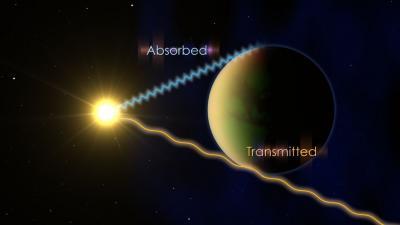Separate teams of scientists have found faint signatures of water in the atmospheres of five distant planets, the first study to conclusively measure and compare the profiles and intensities of these signatures on multiple worlds.
The five planets - WASP-17b, HD209458b, WASP-12b, WASP-19b and XO-1b - are hot Jupiters, massive worlds that orbit close to their stars. The strengths of their water signatures varied. WASP-17b, a planet with an especially puffed-up atmosphere, and HD209458b had the strongest signals. The signatures for the other three planets, WASP-12b, WASP-19b and XO-1b, also are consistent with water.
The water signals were less pronounced than expected, and the scientists suspect this is because a layer of haze or dust blankets each of the five planets. This haze can reduce the intensity of all signals from the atmosphere in the same way fog can make colors in a photograph appear muted. At the same time, haze alters the profiles of water signals and other important molecules in a distinctive way. The researchers were initially surprised that all five appeared to be hazy but other researchers are finding evidence of haze around exoplanets.
The studies were part of a census of exoplanet atmospheres led by L. Drake Deming of the University of Maryland in College Park. Both teams used Hubble's Wide Field Camera 3 to explore the details of absorption of light through the planets' atmospheres. The observations were made in a range of infrared wavelengths where the water signature, if present, would appear. The teams compared the shapes and intensities of the absorption profiles, and the consistency of the signatures gave them confidence they saw water. The observations demonstrate Hubble's continuing exemplary performance in exoplanet research.

To determine what's in the atmosphere of an exoplanet, astronomers watch the planet pass in front of its host star and look at which wavelengths of light are transmitted and which are partially absorbed. Credit: NASA's Goddard Space Flight Center
"These studies, combined with other Hubble observations, are showing us that there are a surprisingly large number of systems for which the signal of water is either attenuated or completely absent," said Heather Knutson of the California Institute of Technology, a co-author on Deming's paper. "This suggests that cloudy or hazy atmospheres may in fact be rather common for hot Jupiters."
Although most of the planets outside of our solar system (called "exoplanets") are too distant to be seen, astronomers have developed indirect methods to determine their size, mass, and even their atmospheric makeup -- taking us one step closer to finding a world like our own. Credit: NASA SVS
Hubble's high-performance Wide Field Camera 3 is one of few capable of peering into the atmospheres of exoplanets many trillions of miles away.
These studies can be done only if the planets are spotted while they are passing in front of their stars. Researchers can identify the gases in a planet's atmosphere by determining which wavelengths of the star's light are transmitted and which are partially absorbed.
Source: NASA/Goddard Space Flight Center




Comments